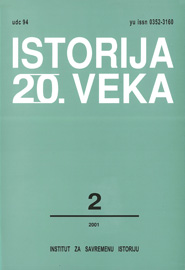O SRPSKOM GRAĐANSTVU 1945 - 1950. U MEMOARISTICI S KRAJA 20. VEKA
SERB BOURGEOISIE 1945 - 1950 IN LATE 20TH CENTURY MEMOIRS
Author(s): Nataša MilićevićSubject(s): Political history, Social history, Recent History (1900 till today), WW II and following years (1940 - 1949), Post-War period (1950 - 1989), Transformation Period (1990 - 2010), History of Communism
Published by: Institut za savremenu istoriju, Beograd
Keywords: Serbia; Serb bourgeoisie; 20th century; communist authorities;
Summary/Abstract: The encounter between the Serb bourgeoisie and the new communist authorities in the years immediately following World War Two set off a complex process in the course of which the two sides gradually formulated views of „the others” but also of their own social group. The work presents a study of this phenomenon based on the memoirs of members of the Serb bourgeoisie. The author focuses on elements on the basis of which these perceptions were formed, such as the structure, character, and significance of the two social groups or the personal experiences of specific members of these groups, etc. Perceptions of the Serb bourgeoisie and of the communist social reality were formed according to periods. The initial views were formed before the first direct encounter and before the liberation of 1944, the second period that affected changes in perception is marked by the first encounter of the bourgeoisie and the communists, while the third period involves the experience of being forced to live together. Particular attention is lent to the perceptions formed in the latter two periods, with the exception of the idea of pre-Revolutionary bourgeois life, which was formed much earlier in bourgeois society. This idea was of crucial importance, since it inevitably became the bourgeoisie’s main criterion in their judgment of the new communist concept of government and state. The other ideas, some twenty of them, that have been singled out in this work, were formed as a result of the first direct encounter of the two groups or in the course of their life side by side once the communist rule had become established. The basic types of views centered around several points, such as the impression that the liberation was in fact „another invasion”, the idea that the new system of government was temporary, stolen votes, various questions regarding private property, the question of Serb nationality (executions, the Srem Front as „civil war in peace”), active or passive resistance, the compromises made by members of the bourgeoisie and their integration in the new communist social environment, the primitivism of the representatives of the new regime, etc. As „long-term phenomena” the majority of these views underwent gradual adjustments, however some of them can be said to have been formed in the first contact between the bourgeoisie and the communists, such as the notions of „communist justice” or „communist injustice”, while others represented only the initial impression whose final form, imparted in the authors’ memoirs, was of a later date, such as the view that the liberation was only „another invasion”. The views studied in the memoirs of members of the Serb bourgeoisie were neither entirely positive or totally negative since ideological notions in regard to the communist society differed, ranging from enthusiastic support to unconditional rejection.
Journal: Istorija 20. veka
- Issue Year: 2001
- Issue No: 2
- Page Range: 111-127
- Page Count: 17
- Language: Serbian

